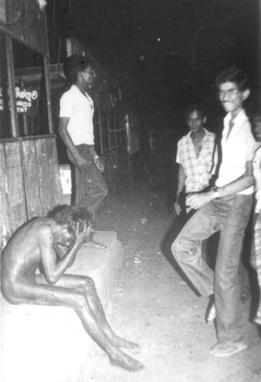
The Sri Lankan Civil War was a civil war fought in Sri Lanka from 1983 to 2009. Beginning on 23 July 1983, it was an intermittent insurgency against the government by the Velupillai Prabhakaran-led Liberation Tigers of Tamil Eelam. The LTTE fought to create an independent Tamil state called Tamil Eelam in the north-east of the island, due to the continuous discrimination and violent persecution against Sri Lankan Tamils by the Sinhalese-dominated Sri Lanka government.

Indian Peace Keeping Force (IPKF) was the Indian military contingent performing a peacekeeping operation in Sri Lanka between 1987 and 1990. It was formed under the mandate of the 1987 Indo-Sri Lankan Accord that aimed to end the Sri Lankan Civil War between Sri Lankan Tamil militant groups such as the Liberation Tigers of Tamil Eelam (LTTE) and the Sri Lankan military.
Krishanti Kumaraswamy, also spelled Krishanthi Kumaraswamy, was a Tamil woman in Sri Lanka who was raped and murdered on 7 September 1996 by six Sri Lankan Army soldiers; the effort to bring her assailants to justice became a cause célèbre as a part of the protest against atrocities committed by the Sri Lankan Army during the Sri Lankan Civil War.

Black July was an anti-Tamil pogrom that occurred in Sri Lanka during July 1983. The pogrom was premeditated, and was finally triggered by a deadly ambush on 23 July 1983, which caused the death of 13 Sri Lanka Army soldiers, by the Tamil militant group Liberation Tigers of Tamil Eelam (LTTE). Although initially orchestrated by members of the ruling UNP, the pogrom soon escalated into mass violence with significant public participation.
Human rights in Sri Lanka provides for fundamental rights in the country. The Sri Lanka Constitution states that every person is entitled to freedom of thought, conscience and religion, including the freedom to have or to adopt a religion or belief of his choice. And, that every person is equal before the law.
The Eastern University massacre was the arrest and subsequent mass murder of 158 minority Sri Lankan Tamil refugees who had taken refuge in the Eastern University campus close to the city Batticaloa on September 5, 1990. A witness identified Sri Lankan Army personnel as the perpetrators. The event is part of what is known amongst Sri Lankan Tamils as Black September, a series of civilian massacres. The Sri Lankan government eventually established a presidential commission of inquiry. The inquiry found evidence of illegal abductions and mass murder. It also named the responsible parties, but there is currently no evidence of any judicial follow up to the inquiry.

Nadarajah Raviraj was a Sri Lankan Tamil lawyer and politician. He was Mayor of Jaffna in 2001 and a Member of Parliament for Jaffna District from 2001 to 2006. A member of the Tamil National Alliance, he was shot dead on 10 November 2006 in Colombo.
The Mylanthanai massacre happened on August 9, 1992 when 35 minority Sri Lankan Tamils, including 14 children, at Mylanthanai in Batticaloa District in Sri Lanka, were killed.
In 1998, allegations of mass graves at Chemmani were made by a Sri Lankan soldier on trial for rape and murder. He claimed hundreds of people who disappeared from the Jaffna peninsula after it was retaken by Government troops from the LTTE in 1995 and 1996 were killed and buried in mass graves near the village of Chemmani. There are reports about 300 to 400 bodies being buried there.

The Duraiappa stadium mass grave was discovered and excavated at the Duraiappah Sports Stadium in the formerly embattled northern city of Jaffna, Sri Lanka, during a period of relative calm between civil conflicts. The mass grave was unearthed in stages between April 4 and 10 of 1999.
Thiyagarajah Maheswaran was a Tamil Sri Lankan Member of Parliament (MP) from Colombo. He belonged to the main opposition United National Party and was critic of Rajapakse government's war against Tamil rebels. He was the former Hindu Affairs minister and a former Member of Parliament for Colombo District, escaped an assassination attempt on the final day of the 2004 election campaign in Colombo. He was assassinated by a gunshot on 1 January 2008 while worshipping at a Hindu temple with his family. Number of other devotees were also injured. The injured gunman has been apprehended and is in police custody in a hospital.
Vijayakala Maheswaran, MP is a Sri Lankan Tamil politician. A Member of Parliament from the Jaffna District, she is the former State Minister for Education and is a former State Minister of Child Affairs and Deputy Minister of Women's Affairs. She lost her seat in the parliament in 2020 general election.
Udara Rathnayake is an actor in Sri Lankan cinema and television as well as a businessman and politician by profession. He is most notable for the roles in films Ira Handa Yata and Nela directed by his father.
Major General Ananda Sri Sisira Kumara Hamangoda, RWP, RSP, USP was a senior Sri Lanka Army officer, who was the former brigade commander of the 51-2 Brigade based in Jaffna, when he was killed by a LTTE female suicide bomber.

Sivaloganathan Vithiya was an 18 year old Sri Lankan Tamil schoolgirl who was gang raped and murdered on the island of Pungudutivu in northern Sri Lanka in May 2015.
The Murunkan massacre of Inspector Bastianpillai and his team of police officers was the mass murder of a team of CID officers of the Sri Lanka Police on 7 April 1978 in the jungles of Murunkan in the Vavuniya District. Four police officers including Inspector Bastianpillai were killed by LTTE members led by Uma Maheswaran.
Sexual violence against Tamils in Sri Lanka has occurred repeatedly during the island's long ethnic conflict. The first instances of rape of Tamil women by Sinhalese mobs were documented during the 1958 anti-Tamil pogrom. This continued in the 1960s with the deployment of the Sri Lankan Army in Jaffna, who were reported to have molested and occasionally raped Tamil women.






